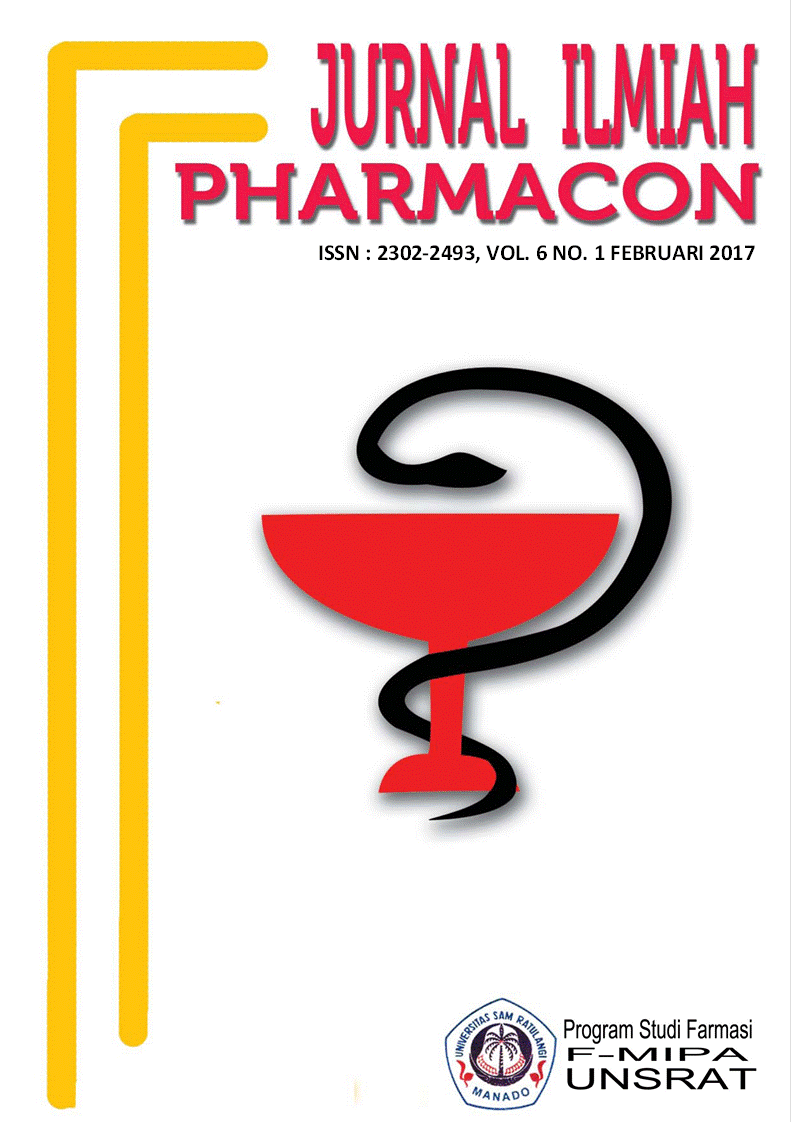UJI DAYA HAMBAT EKSTRAK ETANOL BIJI PINANG YAKI (Areca vestiaria) TERHADAP BAKTERI Stapyhlococcus aureus, Escherichia coli, Pseudomonas aeruginosa
DOI:
https://doi.org/10.35799/pha.6.2017.15003Abstract
UJI DAYA HAMBAT EKSTRAK ETANOL BIJI PINANG YAKI (Areca vestiaria) TERHADAP BAKTERI Stapyhlococcus aureus, Escherichia coli, Pseudomonas aeruginosa
Caesar H. Rundengan 1), Fatimawali 1), Herny Simbala 1)
1)Program Studi Farmasi FMIPA UNSRAT Manado, 95115
Â
ABSTRACT
This study aims to determine the antibacterial activity from ethanol extract of seed of pinang yaki (Areca vestiaria) against the growth inhibition of the bacterium Escherichia coli, Staphylococcus aureus, and Pseudomonas aeruginosa using three concentrations of 30%, 60% and 90%. Extraction was done by maceration method using ethanol 96%. Antibacterial activity test was performing using the paper disk diffusion method (Kirby and Bauer diffusion). The results of antibacterial activity test were analyzed by the method of classification according to the antibacterial degree of strength. Data analysis showed that the extract with the concentration of 30%, 60% and 90% had shown inhibition activity against the growth of test bacteria. At the concentration of 30%, 60% and 90% against the bacterium Escherichia coli was categorized in the class of strong, while at the concentration of 60% and 90% against the bacterium Staphylococcus aureus and Pseudomonas aeruginosa was categorized in the class of very strong and extract with concentrations of 30% was categorized in the class of strong against the bacterium Staphylococcus aureus and Pseudomonas aeruginosa. In all three used concentrations, the concentration of 60% was the concentration, which have the greatest inhibition activity against the three bacteria.
Keywords: Antibacterial activity, Areca vestiaria, bacterial pathogens, agar diffusion method.
Â
ABSTRAK
Penelitian ini bertujuan untuk mengetahui aktivitas antibakteri dari ekstrak etanol biji pinang yaki (Areca vestiaria) terhadap daya hambat pertumbuhan bakteri Escherichia coli, Staphylococcus aureus dan Pseudomonas aeruginosa menggunakan tiga konsetrasi yakni 30%, 60% dan 90%. Ekstraksi dilakukan dengan cara maserasi menggunakan etanol 96%. Pengujian aktivitas antibakteri menggunakan metode difusi dengan cakram kertas (difusi Kirby dan Bauer). Hasil uji aktivitas antibakteri dianalisa dengan metode pengelompokkan berdasarkan tingkat kekuatan antibakteri. Dari analisa data didapatkan bahwa konsentrasi ekstrak 30%, 60% dan 90% telah menunjukkan aktivitas menghambat terhadap pertumbuhan bakteri uji. Pada konsentrasi 30%, 60% dan 90% pada bakteri Escherichia coli termasuk dalam golongan kuat sedangkan konsetrasi 60% dan 90% pada bakteri Staphylococcus aureus dan Pseudomonas aeruginosa termasuk dalam golongan sangat kuat dan konsentrasi ekstrak 30% termasuk dalam golongan kuat pada Staphylococcus aureus dan Pseudomonas aeruginosa. Pada ketiga konsentrasi yang digunakan, konsentrasi 60% merupakan konsentrasi yang memiliki daya hambat paling besar pada ketiga bakteri.
Â
Kata kunci : aktivitas antibakteri, Areca vestiaria, bakteri pathogen, metode difusi agar.
Â
Â
Downloads
Published
How to Cite
Issue
Section
License
Authors who publish with this journal agree to the following terms:
- Authors retain copyright and grant the journal right of first publication with the work simultaneously licensed under a Creative Commons Attribution-NonCommercial 4.0 International License that allows others to share the work with an acknowledgement of the work's authorship and initial publication in this journal.
- Authors are permitted and encouraged to post their work online (e.g., in institutional repositories or on their website) prior to and during the submission process, as it can lead to productive exchanges, as well as earlier and greater citation of published work (See The Effect of Open Access)










